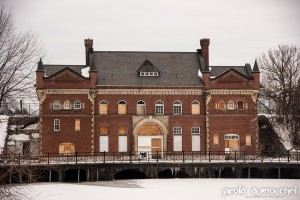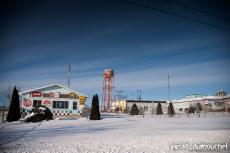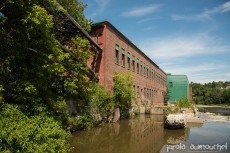The place is big, very big. While the building is nearly 200,000 square feet, the site, meanwhile, is over than 430,000 square feet in an agricultural area of Saint-Jean-sur-Richelieu. For those interested, the site is for sale and the current...
The abandoned power plant
Pretty from the outside, ugly from the inside
Its architecture reminds of the old ramparts of Quebec instead the image to which one is accustomed to power plants.
Yet it is part of this canadian architectural style of the late nineteenth and much of the twentieth century. One of the few industrial buildings inspired by the architectural wave, by cons. Built in a little less than a year in 1899, the building was divided into three parts: the machinery was in the central portion; left were the quarters of the workers and warehouse was located to the right. Today, the three divisions remain, but while the central part has been emptied of its contents, the two wings have been converted into apartments. The rooms are small and the stairs are narrow and the floor could collapse at any time under the weight of visitors.
Historic monument since 2007, the building now belongs to the city who wishes to promote this building with a project to be defined. Although it does not seem to have any water infiltration, its structure is not in a good shape. Many bricks threaten to collapse in several places, the floors are dangerously wavy and many stilts have been added to the outer gallery to prevent it from sinking into the small marsh.
Real vestige of a era when electricity had not yet been nationalized, it is one of the last four hydroelectric plants that remain among the 87 built in Quebec before 1900. With the electricity produced, the plant was able to light and operate the different locks, swing bridges and weirs. The operation of the canal was therefore maximized and allow workers to manage the seaway during day and night.
The plant ceased operations in 1959.
Related content
Hochelaga-Maisonneuve has been deeply marked by the train, in its development. Even today, it is surrounded by three tracks : the Canadian Pacific to the west, the now abandoned Canadian National to the east and the one of the port of Montreal to...
The building, called the Omnipac, is for sale and the sellers offer a touch of humor to attract potential buyers. "Completely renovated," says the sign even if there is a graffiti invasion on every walls and all windows are missing. The place is...
It was October 3, 2014 when it has been heard for the last time the siren for the end of the work shift. The last 180 employees picked up their belongings and closed the door behind them, thus ending an industrial history of over 125 years.
...



















